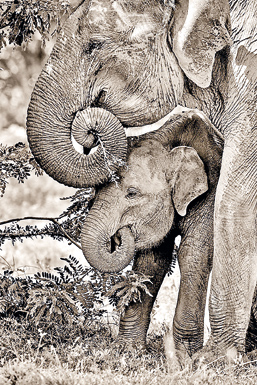‘Animal Verses’: A wildlife blockbuster
Photographic books celebrating Sri Lanka’s wildlife wealth have been steadily accumulating since Nihal Fernando’s pioneering tome The Wild, The Free, the Beautiful (Studio Times, 1986). While almost every succeeding year has seen the publication of new contributions in this genre, a steady trend in content too, has become discernible in the quarter century during which this art has matured.
In the beginning, these coffee-table wildlife books were in essence attempts to paint Sri Lanka as a still pristine succession of spectacular landscapes, while later volumes tended to specialise in animal portraiture as an art form. These two lines of art would develop until the standard of photography had risen so high that it seemed there was no new ground left to break. And remember that for the most part the artists responsible for this work were almost all amateurs in the pure sense of that word (i.e. lovers of their art) trying desperately to hold down day jobs, not BBC-style professionals with multimillion-dollar budgets at their disposal.
Finally in 2010, when it seemed that a ceiling had been reached, Lalith Ekanayake bucked the trend by producing The Untamed Road,a work that seemed to herald a fresh conception of the coffee-table wildlife album. At the time, many people no doubt reacted to the name of the book’s author with a curious “Who?”He was, after all, not at the time a name well known in wildlife circles (all that has changed since). The past three years, however, have provided us with opportunities to digest Dr. Ekanayake’s photographic work and recognise that he has indeed broken new ground. The Untamed Road was special because for the most part its images depicted animals in motion, especially the tension between predator and prey. So vivid were the action sequences of which these photographs were in effect stills, that one couldn’t help wishing that instead of a book he had produced a video documentary. Attenborough himself might have smiled on such a work.

An image from the book ‘Animal Verses’
Now, just three years later, Dr. Ekanayake, a consultant physician who doubles also as a Rear Admiral and Director of Medical Services in the Sri Lanka Navy, has sprung another rabbit from his hat. His latest opus, Animal Verses: the Unseen Wilderness of Sri Lanka, easily surpasses even the high bar set by The Untamed Road. First, the book is produced in an unusual format: a page-size of 34×24 cm (13½”x10”), with the photographs framed within a white margin. This is a refreshing departure from the established style in which images ‘bled’ the margins of the page, leaving no white space at all. As it is, the book puts art ahead of content as is becoming more usual, e.g., in the better class of photographic books being published in Europe. Produced in Singapore, it is certainly printed and bound to a quality that is up there with the best of them, on quality non-reflective white paper in realistic, understated colour with just the right gloss of varnish. Print rarely comes better than this.
That said, it is not for the quality of production that this book will receive acclaim, but for the photographs. Of these there are some 150, almost all of award-winning quality. The vast majority are images any of us would be lucky to see in a few dozen trips to the wild, seized in split-second pressings of the shutter-button for which Lalith Ekanayake is now well known. Roseate Terns quarrelling in mid-air, a crocodile ripping the skin off a spotted deer, a Crested Hawk Eagle pouncing on a land monitor, numerous waders snatching fish from the water: one after the other the images inspire in the reader emotions of awe and wonder in equal measure, not unmingled in my case, I confess, with a sprinkling of envy.
The photographs, however, are not mere snapshots taken in haste. Each of them is carefully framed, beautifully lit and elegantly composed. Each is a work of art, the product of endless hours of lying in wait for that once-in-a-lifetime opportunity. While most of the books content originates in Yala, several images from Sinharaja and other wet-zone forests too, embellish its pages, most memorably for me the rainforest tree-climbing crab that is among the very few species anywhere in the world to accomplish this feat. But I suspect it would be the Greater Crested Tern chick, just hatched and making its way across an exposed sandbank somewhere in the Gulf of Mannar, that would capture the imagination of most readers. It is among the most memorable images I have ever seen, especially in the context of the opposite page bearing a photograph of the egg, from which the chick (presumably) was shortly to emerge.
As with Dr. Ekanayake’s previous book, Animal Verses too, is short on text. The author clearly wishes the photographs to tell the story, keeping the descriptive text to a minimum: barely more than the name of the species depicted, together with the briefest of contextual notes. It is hard to decide whether these were intended to be read as prose or poetry, although the Sinhala text suggests the latter. Yes, you read that right—Sinhala text, yet another way in which this book breaks new ground. It is refreshing to see a coffee-table book adopting the Sinhala language alongside English, underlining the fact that readers of the vernacular too, cherish nature every bit as much as Sri Lanka’s English-speaking middle class.
I have no doubt it is set to grace bookshelves and coffee tables throughout the land, inspiring the island’s nature photographers to attempt yet new heights.
Animal Verses: the Unseen Wilderness of Sri Lanka sets a new standard for photographic books on Sri Lankan natural history. As MP Namal Rajapaksa observes in his Foreword, “It highlights beautifully the natural riches of Sri Lanka, underlining how fortunate we are to live in this wonderful land.”How fortunate, indeed.
comments powered by Disqus

